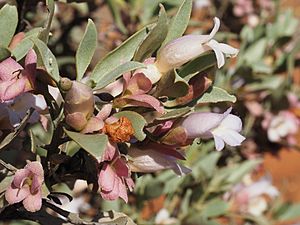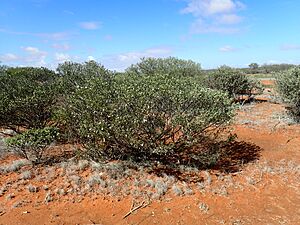Eremophila tietkensii facts for kids
Quick facts for kids Eremophila tietkensii |
|
|---|---|
 |
|
| Eremophila tietkensii leaves and flowers | |
| Scientific classification | |
| Genus: |
Eremophila (plant)
|
| Species: |
tietkensii
|
| Synonyms | |
|
Eremophila latrobei var. tietkensii (F.Muell. & Tate) Ewart & P.H.Jarrett |
|
Eremophila tietkensii is a beautiful flowering plant that belongs to the figwort family. This plant is special because it only grows naturally in Australia. It's a shrub that can be rounded or flat on top. It has pretty grey-green leaves. Its flowers often have pinkish-purple parts called sepals and petals that can be mauve, pink, or lilac. You can find this plant mostly in Western Australia, but it also grows in the western part of the Northern Territory.
Contents
What Eremophila tietkensii Looks Like
Eremophila tietkensii is a shrub that can be rounded or flat on top. It usually grows to be about 0.6 to 2.5 meters (2 to 8 feet) tall. Its branches and leaves are covered with fine grey hairs.
The leaves are grey-green and grow one after another along the branches. They have a flat stalk that is about 6 to 12 millimeters (0.2 to 0.5 inches) long. The leaf itself is shaped like a spear or an egg. It is usually 30 to 72 millimeters (1.2 to 2.8 inches) long and 6 to 17 millimeters (0.2 to 0.7 inches) wide. The surface of the leaf is smooth.
The flowers grow in groups of up to four where the leaves meet the stem. Each flower has a hairy stalk that is usually 6.5 to 14 millimeters (0.3 to 0.6 inches) long. There are five sepals, which are leaf-like parts that protect the flower bud. These sepals are green or pinkish-purple and are about 7.5 to 15 millimeters (0.3 to 0.6 inches) long. They are hairy, especially around the edges.
The petals are joined together at the bottom to form a tube. This tube is 22 to 28 millimeters (0.9 to 1.1 inches) long. The outside of the petal tube can be pale lilac, pale mauve, or pink. Inside, it is white with purple spots. The outside of the tube is slightly hairy, but the inside of the petal tips is smooth. The inside of the tube is full of long, woolly hairs. There are four stamens (the parts that make pollen) hidden inside the petal tube.
This plant flowers between April and October. After the flowers, it produces dry, woody fruits. These fruits are oval or cone-shaped with a distinct point and are about 6 to 7 millimeters (0.2 to 0.3 inches) long.

How Eremophila tietkensii Got Its Name
The plant Eremophila tietkensii was first officially described in 1890. Two scientists, Ferdinand von Mueller and Ralph Tate, wrote about it. They used plant samples collected during an expedition in 1889 by William Tietkens in the Northern Territory.
Later, in 1928, two other scientists, Alfred James Ewart and Phyllis Heather Jarrett, thought this plant was just a type of Eremophila latrobei. However, after looking closely at the original samples and comparing them, another scientist named Robert Chinnock decided in 2007 that it was indeed its own unique species. He went back to the original name. The name tietkensii honors the explorer William Tietkens.
Where Eremophila tietkensii Lives
This type of eremophila plant is found in many places in Western Australia. It grows in inland areas between the Rawlinson and Barlee mountain ranges. You can find it on rocky slopes, flat areas with stony clay, and rolling plains. It grows in several different natural regions, including the Carnarvon, Central Ranges, Gascoyne, Gibson Desert, Great Sandy Desert, Little Sandy Desert, Murchison, and Pilbara areas. It also grows in the far southwest of the Northern Territory.
Growing Eremophila tietkensii in Gardens
If you grow Eremophila tietkensii in the right conditions, it becomes a compact, rounded shrub. It has grey-green, tough leaves and produces many pinkish flowers in early spring. The colored sepals stay on the plant even after the petals fall off, which looks very pretty.
It can be tricky to grow new plants from seeds or cuttings. However, it grows well if you graft it onto another plant called Myoporum. This plant likes soil that drains well and a sunny spot. It can handle dry weather, so it only needs water occasionally during long dry periods. But be careful, it doesn't like frost!
Protecting Eremophila tietkensii
The Western Australian Government's Department of Parks and Wildlife says that this plant species is "not threatened." This means it is not currently at risk of disappearing.

